
The bright-line brown-eye is a moth of the family Noctuidae. The species was first described by Carl Linnaeus in his 1758 10th edition of Systema Naturae. It is a common species throughout Europe, but is also found in North Africa, temperate North Asia and Central Asia, Asia Minor, Syria, and Turkestan, northern India, China, Korea and Japan.

The burnet companion moth is a moth of the family Erebidae. It is found in most of the Palearctic realm, from Ireland in the west to Mongolia and Siberia in the east and south to the Mediterranean and North Africa.
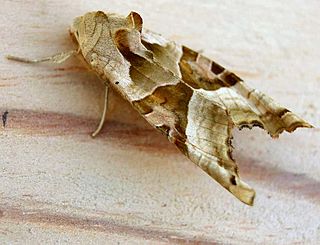
The angle shades is a moth of the family Noctuidae. The species was first described by Carl Linnaeus in his 1758 10th edition of Systema Naturae. It is distributed throughout Europe as far east as the Urals and also in the Azores, in Algeria, and in Asia Minor, Armenia, and Syria. It is strongly migratory.

Apamea monoglypha, the dark arches, is a moth of the family Noctuidae. The species was first described by Johann Siegfried Hufnagel in 1766. It is a common, sometimes abundant, European species. It is found in most of Europe except northernmost Fennoscandia and the southern parts of the Iberian Peninsula and Greece. The species is also found in Anatolia, Turkestan, Western Asia and Central Asia, Siberia and Mongolia. In the Alps it is found up to heights of 2,500 meters. The smaller subspecies sardoa is found on Sardinia and Corsica.

Apamea remissa, the dusky brocade, is a species of moth of the family Noctuidae. It is distributed throughout Europe and Turkey, ranging across the Palearctic realm to Siberia, Manchuria and Japan. It has also been reported from Alaska.

Dysgonia algira, the passenger, is a moth of the family Noctuidae. The species was first described by Carl Linnaeus in 1767 and is found in the Palearctic - from the southern half of Europe and parts of North Africa through West, Central and South Asia.
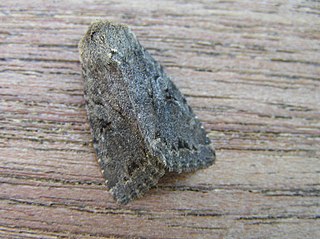
Fissipunctia ypsillon, the dingy shears, is a species of moth of the family Noctuidae. It is found in the Palearctic realm.

Schrankia costaestrigalis, the pinion-streaked snout, is a species of moth of the family Erebidae. It is found in Europe, the Canaries, Madeira, Syria, Armenia. It is also present in New Zealand. The species closely resembles Crambidae or Pyralidae species.

Catocala sponsa, the dark crimson underwing, is a species of moth of the family Erebidae. It is found in Europe, North Africa and from Anatolia up to the Caucasus.

Anaplectoides prasina is a species of moth of the family Noctuidae. It is found in both the Palearctic and Nearctic realms.
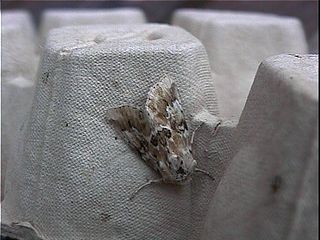
Eremobia ochroleuca, the dusky sallow, is a moth of the family Noctuidae. It is found in Central and Southern Europe and the Middle East.

Heliothis nubigera, the eastern bordered straw, is a species of moth of the family Noctuidae. It is found in arid areas in the Palearctic realm.

Apamea oblonga, the crescent striped, is a moth of the family Noctuidae. The species was first described by Adrian Hardy Haworth in 1809. It is found in northern and central Europe, east to southern Russia, Asia Minor, Armenia, Turkestan, Turkey, Iran, southern Siberia, northern Pakistan, Mongolia, China, Sakhalin and Japan

Dichagyris forcipula is a moth of the family Noctuidae. It is found from central and southern Europe and Algeria, east to the Caucasus, Turkey, Syria, Lebanon, Iraq and Iran.

Orthosia gracilis, the powdered Quaker, is a moth of the family Noctuidae. It is found in all of Europe except the extreme north and south, then east across the Palearctic to Northern Asia and Central Asia. O. g. pallidior is described from Xinjiang in China.

Cucullia xeranthemi is a species of moth of the family Noctuidae. In southern Europe, it is found locally from northern Spain, Italy and southern France to the Balkans. In the east, it is found from Lower Austria and Hungary to southern Russia and western Siberia.

Hypenodes humidalis, the marsh oblique-barred, is a moth in the family Erebidae. The species was first described by Henry Doubleday in 1850. It is found in most of Europe and across the Palearctic to Siberia.
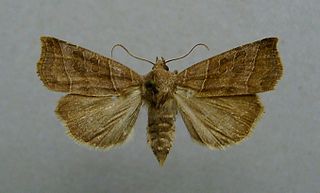
The double kidney is a moth of the family Noctuidae. It is found in most of Europe. In the east, the range extends through Turkey, Siberia, Mongolia and China to Korea and Japan. The habitat consists of damp marshy places.

Mniotype adusta, the dark brocade, is a moth of the family Noctuidae. It was described by Eugenius Johann Christoph Esper in 1790. It is found throughout much of the Palearctic from Europe to Japan, China and Mongolia. It is also found in North America. The habitat consists of heathland, chalky downland, fenland, moorland and upland areas.
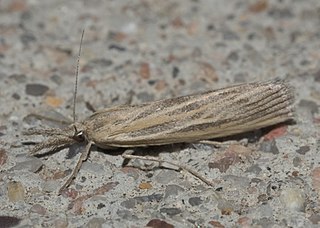
Thaumatopsis pexellus, the woolly grass-veneer, is a moth in the family Crambidae. It was described by Philipp Christoph Zeller in 1863. It is found in most of North America. The habitat consists of grasslands.



















